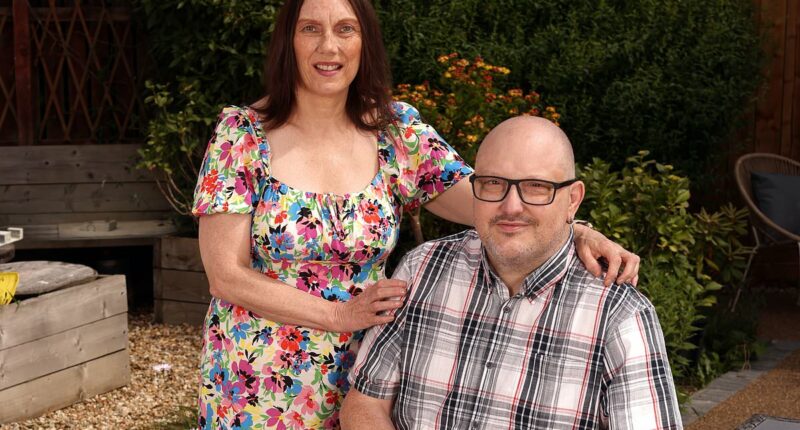Share this @internewscast.com
Following a day of sightseeing, Chris Dolan noticed a blister on the outside of his right foot when removing his socks.
What appeared to be a minor injury ultimately resulted in him, just like many other Britons each week, confronting the possibility of needing to have his foot amputated.
But thanks to an innovative surgical technique, not only was Chris’s foot saved but he has even been able to take up ‘walking’ rugby.
It nearly didn’t end so positively. In June 2023, Chris, 50, and his wife Jane, 57, both civil servants, were on a cruise in Norway when he developed the blister. Initially, it was about 10mm wide. But after eight weeks, despite him meticulously keeping the blister clean and dry, it became badly infected.
This was particularly serious as Chris has type 1 diabetes, which means his body doesn’t produce the hormone insulin, needed to control blood sugar levels, so he relies on injecting artificial insulin.
Even if it is well managed, both type 1 and type 2 diabetes can lead to peripheral neuropathy where, over time, high levels of glucose in the blood damage the nerves in the extremities, causing numbness and tingling. If the foot is affected, it means patients can suffer a foot injury without even feeling it.
As well as neuropathy in his foot, Chris had developed peripheral arterial disease (PAD), where a build-up of fatty deposits in the arteries restricts blood supply to the limbs, compounding any nerve damage.

In June 2023, Chris, 50, and his wife Jane, 57, both civil servants, were on a cruise in Norway when he developed the blister that nearly caused his foot to be amputated
In severe cases (if a cut or scratch won’t heal and becomes badly infected), peripheral neuropathy can lead to foot or lower limb amputation. More of these amputations are being performed as the number of people with diabetes increases. More than 5.8million people in the UK now live with diabetes, an all-time high, according to charity Diabetes UK.
A further 1.3million could be unaware they have type 2 diabetes because they do not recognise the symptoms. ‘The figures are staggering,’ says Shiva Dindyal, a consultant vascular and endovascular surgeon at the NHS Basildon University Hospital in Essex.
He sees about one patient a day who requires amputation, usually due to a diabetes complication. ‘In England, there are an average 176 leg, toe or foot amputations each week, while across the UK, there are in excess of 9,000 limb amputations annually,’ says Mr Dindyal.
He explains that having excess blood glucose ‘damages everything’, adding: ‘You’re more likely to get an infection, as bacteria like “sugary” blood.
‘Amputation is the last resort because it changes someone’s life. The reality is that a patient has a life expectancy of just 1 per cent five years after an amputation. This is often because they have other health issues, such as high blood pressure or cardiovascular disease or, due to their diabetes, wounds that don’t heal, leading to complications.’ The first step surgically is angioplasty – a procedure which widens narrowed arteries using an inflated balloon or stents – to get the blood to flow back into the foot. If this fails, a bypass operation ‘is the only option’, says Mr Dindyal.
Here an artery, usually taken from the upper thigh, is joined to another blood vessel lower down the leg leading to the foot.
Two months after the blister first appeared, Chris became unwell with a fever as a result of his foot infection. He was admitted to the James Cook University Hospital with sepsis. Fortunately, he was treated in time and was discharged three weeks later.
As well as taking antibiotics, he wore a special compression dressing to stimulate blood circulation to the ulcerated foot. Despite this, the wound became a hole 30mm across and 15mm deep. ‘It looked horrific as you could see the bone,’ says Chris, from Middlesbrough. ‘But I wasn’t in pain because the nerves had been damaged over the years.’

Shiva Dindyal, a consultant vascular and endovascular surgeon at the NHS Basildon University Hospital in Essex

‘In England, there are an average 176 leg, toe or foot amputations each week, while across the UK, there are in excess of 9,000 limb amputations annually,’ says Mr Dindyal
After two months of vacuum treatment on his infected right foot, the wound still hadn’t fully healed and Chris was warned that if the infection could not be successfully treated, he would need his right foot amputated below the knee. But a fortnight later, his consultant told him another specialist in the same hospital might be able to help.
Ian Nichol, a consultant vascular surgeon, is using a new technique called reversed deep venous arterialisation – where a vein (rather than an artery) from the upper leg is used to bypass a blockage and improve blood supply to the foot.
The technique has only been performed in a small number of centres across the world.
Mr Nichol has treated about 25 patients this way in the past three years, with about a 70 per cent success rate in saving a patient from amputation.
Mr Nichol explains: ‘Patients like Chris have what we call a “desert foot”, where there are no arteries remaining to supply blood beyond the ankle and into the foot. Without this, the tissue can break down and die. This develops into an ulcer or gangrene which will not heal.
‘This new technique is different. With no artery to work with, this bypass graft procedure turns a vein, which remain mostly disease-free, into an artery.’ He says: ‘We remove the saphenous vein, which is close to the skin’s surface and runs down from the inside of the thigh to the calf. This vein is then reversed, attaching it to the popliteal artery below the knee, and joining it to a deep vein at ankle level in the foot which also works like an artery, so blood flows in the opposite direction, taking it to the foot.’
Veins transport blood from the body and back to the lungs to pick up more oxygen.
Mr Nichol says: ‘The valves which line the vein and normally prevent the blood flowing back down it due to gravity have to be destroyed by puncturing them. This allows blood to flow inside like a normal artery. It’s a challenging operation because the vein below the ankle is quite small – 2mm in diameter.

Ian Nichol, a consultant vascular surgeon, is using a technique called reversed deep venous arterialisation – where a vein from the upper leg is used to bypass a blockage
‘This operation isn’t for everyone,’ he adds. ‘Some people do not have suitable veins and some have had enough of trying different procedures and would rather have an amputation. But I hope it becomes more routine. It might save more patients from losing their lower leg.’
Chris had the eight-hour procedure in December 2023. He relied on a wheelchair for a year and, although he wasn’t in pain, admits he felt depressed due to his lack of mobility.
‘At times, I wondered if I should have had the amputation because I could have been learning to walk again after six weeks,’ he says. ‘But I’m now glad I didn’t lose my foot – it was fantastic to get up and start using walking poles.’
There’s still a 5mm-sized ulcer on his foot but it’s thought it will eventually heal.
‘The blood is now getting through to my foot,’ says Chris. ‘I still can’t walk far but I’ve taken up walking rugby. I hope this operation can help others like me avoid an amputation.’











